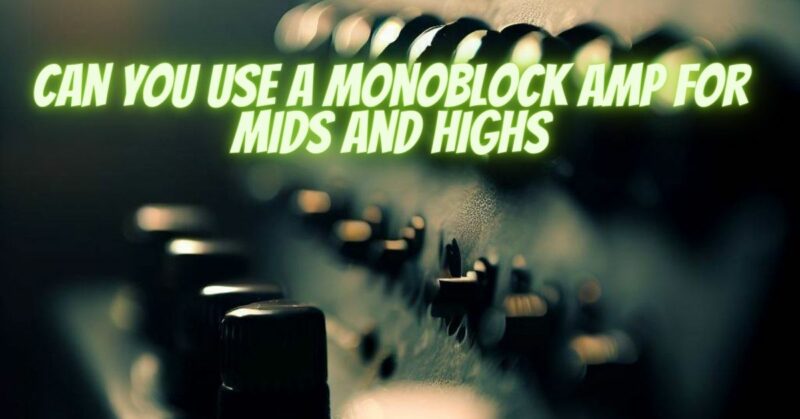The world of audio amplification is a realm of possibilities and experimentation, where enthusiasts constantly seek innovative ways to achieve their desired sound signatures. When it comes to amplifiers, the choice often revolves around efficiency, power, and the specific frequency ranges they are designed to handle. Monoblock amplifiers, traditionally associated with powering subwoofers, have sparked curiosity regarding their potential to drive mids and highs as well. In this article, we’ll delve into the feasibility and considerations of using a monoblock amp for mids and highs, exploring the advantages, challenges, and scenarios where this unconventional approach can yield impressive results.
Understanding Monoblock Amplifiers:
Monoblock amplifiers are dedicated to powering a single channel or speaker, typically used for subwoofers in car audio systems. They are designed to deliver substantial power output to drive low-frequency signals with authority and impact. Monoblocks offer advantages in efficiency, power handling, and bass response, making them ideal companions for subwoofers.
Can Monoblock Amps Handle Mids and Highs?
The question arises: Can monoblock amplifiers effectively handle mids and highs, which demand different characteristics than subwoofers? The answer is nuanced and depends on several factors:
- Power Delivery: Monoblock amplifiers excel in delivering high power output, which can be advantageous when driving mids and highs, especially in demanding listening environments or large spaces.
- Efficiency: Monoblocks are efficient due to their single-channel design. This efficiency can translate into cleaner power delivery to mids and highs, ensuring minimal distortion and preserving audio fidelity.
- Crossover and Equalization: Achieving accurate mids and highs reproduction requires proper crossover points, equalization, and fine-tuning. Monoblocks might lack the specialized crossover features necessary for optimal midrange and high-frequency performance.
Advantages of Using Monoblock Amps for Mids and Highs:
- Power and Impact: Monoblocks can provide ample power to mids and highs, ensuring they can cut through dynamic music passages and deliver impactful sound.
- Dedicated Channel: Using a monoblock for mids and highs allows you to allocate an entire amplifier to these frequencies, reducing the risk of channel sharing and improving clarity.
Challenges and Considerations:
- Crossover Points: Monoblocks might lack adjustable crossover points suitable for mids and highs. The ability to fine-tune the frequency distribution among drivers is crucial for balanced sound.
- Sound Quality: The tonal balance, clarity, and fidelity demanded by mids and highs can be compromised if a monoblock amplifier’s characteristics do not align well with these frequencies.
Ideal Application Scenarios:
- Three-Way Systems: In systems with separate drivers for bass, midrange, and highs, using a monoblock to power the dedicated midrange driver can ensure optimal power delivery and channel separation.
- Large Listening Environments: Monoblocks can provide the necessary power to fill larger spaces with clear and impactful sound, making them suitable for mids and highs in such scenarios.
Using a monoblock amplifier for mids and highs is an unconventional approach that requires careful consideration of your audio goals, system components, and the amplifier’s capabilities. While monoblocks are engineered for powerful bass reproduction, their efficiency and power can potentially benefit mids and highs. However, it’s essential to address challenges related to crossover points, tonal balance, and sound quality. Ultimately, your decision should be based on your specific audio preferences, requirements, and the sonic characteristics you aim to achieve in your unique audio system.


